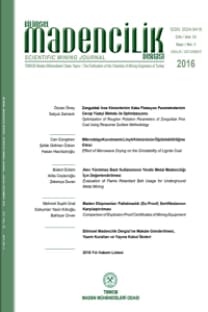DÜŞÜK SiO2 İÇERİKLİ KUVARS KUMUNUN ZENGİNLEŞTİRME İŞLEMLERİ İLE HAMMADDE KAYNAĞI OLARAK KULLANILABİLİRLİĞİNİN İNCELENMESİ
INVESTIGATION OF THE USABILITY OF QUARTZ SAND CONTAINING LOW SiO2 AS A RAW MATERIAL SOURCE WITH ENRICHMENT PROCESSES
silica sand magnetic separation, flotation, oxalic acid leaching,
___
Akçıl, A., Tuncuk, A., Deveci, H., 2007. Kuvarsın Saflaştırılmasında Kullanılan Kimyasal Yöntemlerin İncelenmesi. Madencilik, 46 (4), 3-10.Atak, S. 2017. Flotasyon Cevher Hazırlamada 100 Yıl. İTÜ Vakfı Yayınları.
Al-Maghrabi, M.N.H., 2004. Improvement of low-grade silica sand deposits in JeddahArea, Engineering Science,15, 113–128.
Ambikadevi, V.R. ve Lalithambika, M., 2000. Effect of organic acids on ferric iron removal from iron-stained kaolinite, Applied Clay Science, 16, 133–145.
Arvamangala, H. ve Natarajan, K.A., 2011. Microbially induced flotation of alumina, silica/calcite from haematite. International Journal of Mineral Processing, 99, 70–77.
Banza, A.N., Quindt, J., Gock, E., 2006. Improvement of the quartz sand processing at Hohenbocka. International Journal of Mineral Processing, 79, 76–82.
Buckland, A.D., Rochester, C.H., Topham, S.A., 1980. Infrared study of the adsorption of carboxylic acids on Hematite and Goethite immersed in carbon tetrachloride. Faraday Trans, 176, 302–313.
Bulatovic, S. M., 2007, Handbook of Flotation Reagents: Chemistry, Theory, and Practice, Amsterdam: Elsevier.
Çilek, E.C., 2006. Mineral Flotasyonu. Süleyman Demirel Üniversitesi yayın No:59, Mühendislik Mimarlık Fakültesi, Isparta.
Du, F., Li, J.S., Li, X.X., Zhang, Z.Z., 2011. Improvement of iron removal from silica sand using ultra-assisted oxalic acid. Ultrasonics Sonochemistry, 18, 389–393.
Han, K.N., Healy, T.W., Fuerstenau, D.W., 1973. The mechanism of adsorption of fatty acids and other surfactants at the oxide-water interface. Journal of Colloid and Interface Science, 44, 407–414.
Karagüzel, C., 2019. Endüstriyel Silikatlar, Özellikleri Ve Zenginleştirme Yöntemleri; Genel Bakış. AYDIN Maden Potansiyelinin Değerlendirilmesi Çalıştayı. TMMOB Maden Mühendisleri Odası Yayını.
Kulkarni, R.D., Somasundaran, P., 1975. Kinetics of oleate adsorption at the liquid/air interface and its role in hematite flotation, AIChE Symp. 71, 124–133.
Lanyon, M.R., Lwin, T., Merritt, R.R., 1999. The dissolution of iron in the hydrochloric acid leach of an ilmenite concentrate, Hydrometallurgy, 51, 299–323.
Lee, S.O., Tran, T., Jung B.H., Kim, S.J. ve Kim, M.J., 2007. Dissolution of Iron Oxide Using Oxalic Acid. Hydrometallurgy, 87, 91-99.
Loritsch, K.B. ve James, R.D., 1991. Purified Quartz and Process for Purifying Quartz. United States Patent, Patent Number : 4,983,370.
Mowla, D., Karimi, G., Ostadnezhad, K., 2008. Removal of hematite from silica sand ore by reverse flotation technique. Separation Purification Technology, 58, 419–423.
Nakhaei, F. ve Irannajad, M. 2018. Reagents types in flotation of iron oxide minerals: A review. Mineral Processing and Extractive Metallurgy Review, 39 (2), 89–124.
Özer, M., Başkurt, B., Burat, F., Baştürkcü, H., 2018. Ön Zenginleştirme Sonrasında Oksalik Asit Kullanımı İle Cam Kumu Tesisi Yan Ürününden Düşük Demir İçerikli Mikronize Kuvars Üretimi. Madencilik, 57(2), 109-116.
Palaniandy, S., Azizli, K.A.M., Hussin, H., Hashim, S.F.S., 2007. Study on mechno-chemical effect of silica for short grinding period. International Journal of Mineral Processing, 82, 195–202.
Patermarakis, G. ve Paspaliaris, Y. 1989. The leaching of iron oxides in boehmitic bauxite by hydrochloric acid. Hydrometallurgy, 23, 77–90.
Pattanaik, A., ve Venugopal, R. 2018. Investigation of Adsorption Mechanism of Reagents (Surfactants) System and its Applicability in Iron Ore Flotation – An Overview. Colloid and Interface Science Communications, 25, 41-65.
Peck, A.S., Raby, L.H., Wadsworth, M.E., 1966. An infrared study of the flotation of hematite with oleic acid and sodium oleate. Trans. Metall. Soc. AIME 235, 301–307.
Rao, H., Dwari, K., Lu, R.K., Vilinska, S., Somasundaran, A.S., 2011. Mixed anionic/nonionic collectors in phosphate gangue flotation from magnetic fines, Open Mineral Processing Journal, 14–24.
Shen, X.M., Peng, Z.S., 2008. Study on removal of iron from Gaoping quartz. J. Xiangtan Univ. (Nat. Sci.) 30, 78–79.
Somasundaran, P., Huang, L., 2000. Adsorption and aggregation of surfactants and their mixtures at solid/liquid interfaces. Advances in Colloid and Interface Science, 88, 179–208.
Srdjan, M., 2007. Handbook of flotation reagents, Elsevier, Amsterdam, Netherlands, 1–144.
Styriaková, I., Štyriak, I., Kraus, I., Hradil, D., Grygar, T., Bezdička, P., 2003. Biodestruction and deferritization of quartz sands by Bacillusspecies. Miner. Eng. 16, 709–713.
Taxiarchou, M., Panias, D., Douni, I., Paspaliaris, I., Kontopoulos, A., 1997. Removal of Iron from Silica Sand by Leaching with Oxalic Acid. Hydrometallurgy, 46, 215-227.
Tuncuk, A. ve Akçıl, A. 2016. Iron removal in production of purified quartz by hydrometallurgical process. International Journal of Mineral Processing. 153, 44-50.
URL-1, www.mta.gov.tr/v3.0/bilgi-merkezi/kuvars-kumu. 15 Ağustos 2020.
URL-2,www.mta.gov.tr/v3.0/bilgi merkezi/kuvarsit. 15 Ağustos 2020.
Xuesong, J., Jian, C., Mengnan, W., Feifei, L., Boyuan, B., Jingwei, L. Effect of impurity content difference between quartz particles on flotation behavior and its mechanism. Powder Technology. 375, 504-512.
Vegliò, F., 1997. Factorial experiments in the development of a kaolin leaching process using thiourea in sulphuric acid solutions. Hydrometallurgy, 45, 181–197
Veglió, F., Passariello, B., Abbruzzese, C., 1999. Iron removal process for high-purity silica sands production by oxalic acid leaching. Industrial & Engineering Chemistry Research, 38, 4443–4448.
Zhou, Y.H., 2005. Acidic leaching experiments of highly pure quartz sand. Miner. Rock, 25, 23–26.
- ISSN: 2564-7024
- Yayın Aralığı: 4
- Yayıncı: TMMOB Maden Mühendisleri Odası
DÜŞÜK KALİTE KUVARS KUMLARININ FLOTASYON VE OKSALİK ASİT LİÇİ İLE ZENGİNLEŞTİRİLMESİ
Ş.beste AYDIN, Ceyda OĞUZ, Alim GÜL
ENRICHMENT OF LOW GRADE MAGNETITE ORE BY MAGNETIC AND GRAVITY SEPARATIONS: EFFECT OF PARTICLE SIZE
Hikmet SİS, Tekin KARAAĞAÇ, Mustafa BİRİNCİ, Tufan KIYAK
YERALTI MADENLERİNDE MADEN ARITMA SIRASINDA MASOVİK MADENCİLİK UYGULAMASI
Ş.beste AYDIN, Ceyda OĞUZ, Alim GÜL
KUYUMCULUK KÖKENLİ ARTIKLARDAN ALTIN VE GÜMÜŞÜN GERİ KAZANIMI
Tülin ULUCAN, Mustafa ÖZER, Hüseyin BAŞTÜRKCÜ, Fırat BURAT
BAKIR İÇEREN SİYANÜR LİÇİ ÇÖZELTİLERİNDEN ALTININ SEÇİMLİ OLARAK KAZANIMINDA ADSORBANLARIN ETKİNLİĞİ
Deus Albert MSUMANGE, Ersin Y. YAZICI, Oktay CELEP, Hacı DEVECİ
OLİVİNİN REFRAKTER HAMMADDESİ OLARAK KULLANIMI İÇİN DEMİR İÇERİĞİNİN MANYETİK AYIRMA İLE AZALTILMASI
